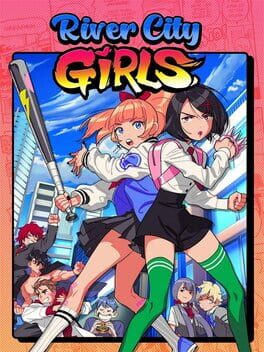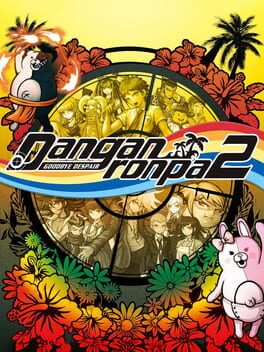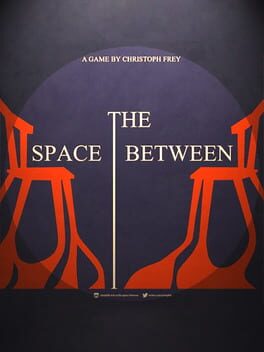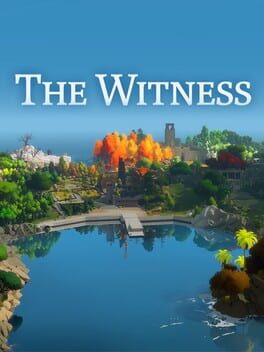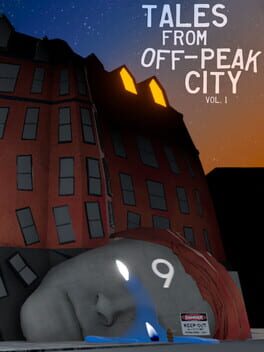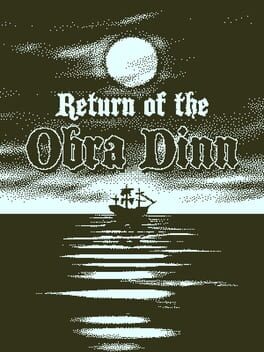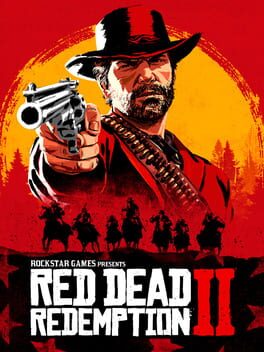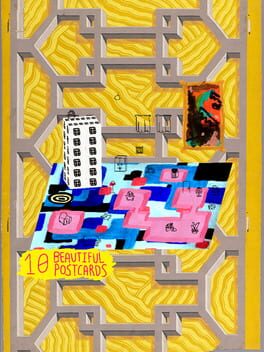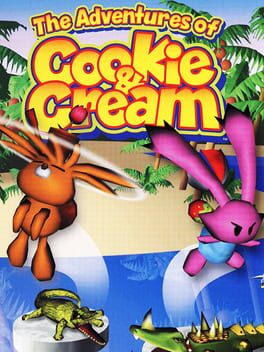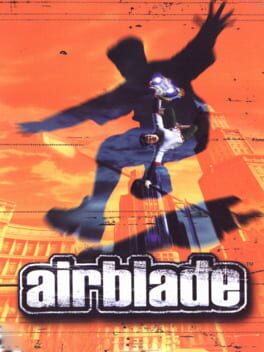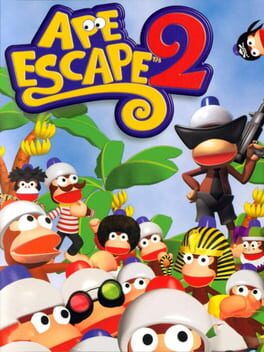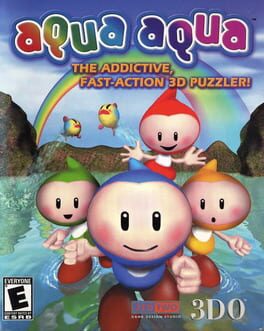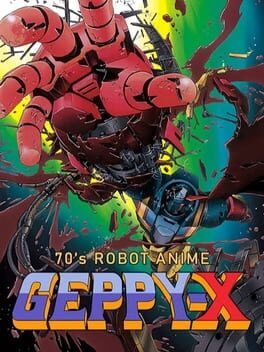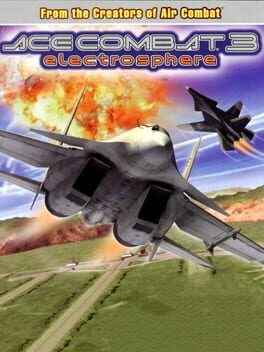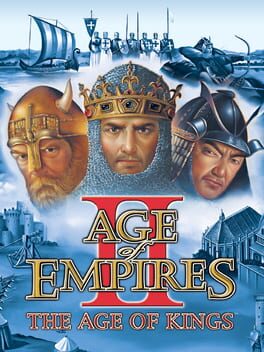Miniike
118 reviews liked by Miniike
River City Girls
2019
I have basically nothing nice to say about this game story wise. I know it really shouldn't matter much for this kinda game but the dialogue was like, distractingly bad. Plus that ending was one of the worst I've ever experienced, Holy fuck. I actually don't know what they possibly thought they were cooking.
Beyond that though... this is a solid game! A bit basic for my likings, but the controls feel nice and I like the more open environments! I also really love the game stylistically, with nice pixilated sprites and honestly fantastic character designs. That might legit be my favorite part of this game, I love the designs so much.
I do wish I liked this more, but as it stands, I did enjoy my time with it.
Beyond that though... this is a solid game! A bit basic for my likings, but the controls feel nice and I like the more open environments! I also really love the game stylistically, with nice pixilated sprites and honestly fantastic character designs. That might legit be my favorite part of this game, I love the designs so much.
I do wish I liked this more, but as it stands, I did enjoy my time with it.
The Space Between
2019
The interplay of intimacy, space, perspective, and barriers form the moody horrors of Frey's The Space Between as surrealism pervades the opaque normalcy of a world turned into hell, accompanied by a descent necessary for this transformation. Protracted sequences of dialogue and walking affirm the intensity of spaces between player and game, spectator and spectacle, audience and actors, which dread the enclosing fragmentation of existential anguish and death: walls not made out of matter. The designer's score, too, sees advanced development from his 2012 "Horror Vacui" to suit the less experimental but no less artistic form Frey's horror becomes in this exceptional game. A deserving Nuovo Award winner, The Space Between enters among my favorite games of 2019 for achieving in 40 or so minutes what most games need 10x or more time (let alone that in resources for graphics, gameplay mechanics, voice acting, etc.) to replicate.
The Witness
2016
Seeing Liz review this here made me remember I once played this! I wrote a really long essay on it that I don't really agree with (please don't dig it up.. or do...)
Perhaps the epitome of the 'teach the player without using words' late 00s/10s philosophy of game design - a not-bad rule of thumb that could (generously) be interpreted as 'maintain some level of clarity/consistency/ design in a way that people can figure out more complex things themselves' that was ultimately twisted into pure idiocy about NEVER USING WORDS that forgets that COMPLETELY NOT USING WORDS ONLY WORKS IF THE GAMEPLAY REALLY FITS OR YOU CAN ASSUME A PLAYER HAS LEGACY KNOWLEDGE FROM PAST GAMES. Sure it's not a bad idea to try and convey puzzle mechanics to players through the experience of using them, but then 10 years of video essays later and everyone thinks it means to make an overwrought first level that 'teaches you how to double jump without using words'. NO!!! THE PRINCIPLE MAKES SENSE IF IT'S SOME PUZZLE GAME LIKE THE WITNESS WHERE THE PUZZLE RULES MAKE INTUITIVE SENSE BUT WOULD BE CLUNKY TO STATE OUTRIGHT!!!!
But... The Witness!! Why do I like it? Why, it has a deep philosophy about the humanity of mankind... NOT!!! I like this game because the puzzles are fun to solve, they interact with the environment, and they sort of acknowledge that a fun part of puzzle solving is failing, walking away and coming back. It incorporates walking way and coming back into the environment and layout! The island is pretty and fun to walk around! The Witness level design "Bangs". I like the tactile feeling and sound design of looking at the panels and drawing the solutions. I could draw those puzzle lines for days.
Look. If I'm being honest I don't really like pure puzzle games that much. I make my little progress across the level select, inevitably get stuck and then forget about the game. My life is a Brain Teaser, I don't want to just Solve Brain Teasers. I don't want to solve middling puzzles in service of revealing some arbitrary conspiracy mystery: I just want to do some fun good puzzles and see some stuff, and this game has that. Playing this was a "Good Time".
Anyways it's time for "Analgesic Lore": did you know a super early version of Even the Ocean - honorary recipient of a 3.6 average Backloggd score rating - was supposed to be a 2D game about exploring islands with PUZZLES...? Well it was, and it never got anywhere because I just don't like puzzles that much, maybe. Then again I made Sephonie's Linking Puzzle system (ironically that game was on an island), which weren't really 'puzzles', but...
More exploration puzzlers set in 3D. Please! Do it for me!
Perhaps the epitome of the 'teach the player without using words' late 00s/10s philosophy of game design - a not-bad rule of thumb that could (generously) be interpreted as 'maintain some level of clarity/consistency/ design in a way that people can figure out more complex things themselves' that was ultimately twisted into pure idiocy about NEVER USING WORDS that forgets that COMPLETELY NOT USING WORDS ONLY WORKS IF THE GAMEPLAY REALLY FITS OR YOU CAN ASSUME A PLAYER HAS LEGACY KNOWLEDGE FROM PAST GAMES. Sure it's not a bad idea to try and convey puzzle mechanics to players through the experience of using them, but then 10 years of video essays later and everyone thinks it means to make an overwrought first level that 'teaches you how to double jump without using words'. NO!!! THE PRINCIPLE MAKES SENSE IF IT'S SOME PUZZLE GAME LIKE THE WITNESS WHERE THE PUZZLE RULES MAKE INTUITIVE SENSE BUT WOULD BE CLUNKY TO STATE OUTRIGHT!!!!
But... The Witness!! Why do I like it? Why, it has a deep philosophy about the humanity of mankind... NOT!!! I like this game because the puzzles are fun to solve, they interact with the environment, and they sort of acknowledge that a fun part of puzzle solving is failing, walking away and coming back. It incorporates walking way and coming back into the environment and layout! The island is pretty and fun to walk around! The Witness level design "Bangs". I like the tactile feeling and sound design of looking at the panels and drawing the solutions. I could draw those puzzle lines for days.
Look. If I'm being honest I don't really like pure puzzle games that much. I make my little progress across the level select, inevitably get stuck and then forget about the game. My life is a Brain Teaser, I don't want to just Solve Brain Teasers. I don't want to solve middling puzzles in service of revealing some arbitrary conspiracy mystery: I just want to do some fun good puzzles and see some stuff, and this game has that. Playing this was a "Good Time".
Anyways it's time for "Analgesic Lore": did you know a super early version of Even the Ocean - honorary recipient of a 3.6 average Backloggd score rating - was supposed to be a 2D game about exploring islands with PUZZLES...? Well it was, and it never got anywhere because I just don't like puzzles that much, maybe. Then again I made Sephonie's Linking Puzzle system (ironically that game was on an island), which weren't really 'puzzles', but...
More exploration puzzlers set in 3D. Please! Do it for me!
Super Mario 64
1996
One of THE games and also one of the few cases where I genuinely think that it's near impossible for me to say anything especially new about it, but god, this game is so good. The atmosphere that this has is particularly interesting, with locations that often feel like sparse game constructs that are only just beginning to take shape as actual locations, but are still forming all the finer details to truly take it to that point. It sits in this middle ground between having naturalistic worlds and abstract, geometrical artifice populating the landscapes, with even the most well-established aesthetics being coupled with strange floating boxes or blatantly mismatching elements, ultimately embodying a lot about what I love about this era of 3D platformers.
Another bit of magic that this game has to me is how its movement plays into its level design. Super Mario 64's character control feels sublime with how cleanly it flows into itself while never making the process of traversing the environment an unintrusive exercise when you're first playing. Mario feels heavy, he's got a lot of jumps that require a semblance of commitment once you begin, there's some precision to be found in stringing everything together as well, but once you begin understanding how to control him, you truly understand just how powerful you are. The level design plays into this fantastically for the most part, with this constant feeling of "if I was just a bit better and more confident at this game, I'm sure there would be a ton of ways to get up here" in most stages, making them feel so mechanically dense, with the potential to learn a lot of basic, tiny skips just through experimenting and messing around with bits of geometry that look vaguely scalable, because there's so much room for this everywhere that you're bound to find a few if you're at all adventurous.
I might not enjoy every stage here, since some do end up being a bit too skeletal for my liking (not too fond of Dire Dire Docks and Snowman's Land mainly), but this game is magical, it's foundational to so much of what I adore and still somehow also has some of the best movement in any game I've played despite also being the blueprint of a lot of it. Also, the experience of playing as a little guy who makes silly noises after literally anything you do is so powerful once you've actually played it yourself, seeing gameplay videos does not convey how funny it is for this to happen for an entire game.
Another bit of magic that this game has to me is how its movement plays into its level design. Super Mario 64's character control feels sublime with how cleanly it flows into itself while never making the process of traversing the environment an unintrusive exercise when you're first playing. Mario feels heavy, he's got a lot of jumps that require a semblance of commitment once you begin, there's some precision to be found in stringing everything together as well, but once you begin understanding how to control him, you truly understand just how powerful you are. The level design plays into this fantastically for the most part, with this constant feeling of "if I was just a bit better and more confident at this game, I'm sure there would be a ton of ways to get up here" in most stages, making them feel so mechanically dense, with the potential to learn a lot of basic, tiny skips just through experimenting and messing around with bits of geometry that look vaguely scalable, because there's so much room for this everywhere that you're bound to find a few if you're at all adventurous.
I might not enjoy every stage here, since some do end up being a bit too skeletal for my liking (not too fond of Dire Dire Docks and Snowman's Land mainly), but this game is magical, it's foundational to so much of what I adore and still somehow also has some of the best movement in any game I've played despite also being the blueprint of a lot of it. Also, the experience of playing as a little guy who makes silly noises after literally anything you do is so powerful once you've actually played it yourself, seeing gameplay videos does not convey how funny it is for this to happen for an entire game.
Cosmo D just keeps getting better! an absolute tour de force of world depth and sound design...like, i could fuck around in these little places forever...my only complaint really is that i thought the main story would be longer, which puts Norwood Suite just a bit above this in terms of overall success imo
bring on vol 2, 3, 4 and beyond!! i fucking love off-peak city dude
bring on vol 2, 3, 4 and beyond!! i fucking love off-peak city dude
Resident Evil 4
2023
rating based on my experience up to chapter 8...which is where i'm putting it down because i feel like i've gotten everything i wanted from the game (and borrowed it anyway)...up to this point, and with no context of any other games in the series, i feel that as a pure survival combat experience this is well-designed and fluid...nothing revelatory but certainly fun and even without playing the original game the mid 00s vibe is palpable and charming
but the primary takeaway, and most valuable to my overall gaming and art journey, is that i'm stopping because i don't really enjoy killing hordes of weird creatures over and over again, however engaging it may be...feels a bit soul-draining and i prefer killing to be a bit more abstracted or light-hearted (or otherwise discouraged i guess)...not that i'm a pacifist (especially in the context of fiction because it aint real) but it's just a taste i've come to accept...i can do this shit but maybe this genre is outside of what i want out of immersive art
that being said, i'm still gonna try other things in what i assume are a similar mode (Bloodborne etc)...but overall i'll be prioritizing other stuff for a while to see where that directs my taste :)
but the primary takeaway, and most valuable to my overall gaming and art journey, is that i'm stopping because i don't really enjoy killing hordes of weird creatures over and over again, however engaging it may be...feels a bit soul-draining and i prefer killing to be a bit more abstracted or light-hearted (or otherwise discouraged i guess)...not that i'm a pacifist (especially in the context of fiction because it aint real) but it's just a taste i've come to accept...i can do this shit but maybe this genre is outside of what i want out of immersive art
that being said, i'm still gonna try other things in what i assume are a similar mode (Bloodborne etc)...but overall i'll be prioritizing other stuff for a while to see where that directs my taste :)
A genuinely magical game that’s kept me thinking about it and will continue having this grip on me for quite some time. Games that utilise the medium to such an extent that their identity hinges on the interactive element being present are some of the most fun ones to let sit with you, and this is one of my favourite instances of it. Return of the Obra Dinn is one of the greatest mystery games I’ve played and a lot of this is owed to the structure of the game, forgoing crafting a mystery specifically designed to surprise the player with its various twists and instead laying it all out bare and forcing you to pick everything apart to fully grasp the finer details of things. The mystery and story themselves are not the important aspects here, it’s just trying to immerse you into the role of a detective without any handholding beyond the bare essentials, and it does so perfectly.
Return of the Obra Dinn is a mystery/puzzle game that revolves around incomplete information and assumption, often leaving little to no definitive evidence and forcing you to jump all around to place with increasingly tenuous lines of logic as you feel yourself going insane. It was quite funny taking a step back after combing through a few scenes in excruciating detail and just thinking “wow, this is deranged” but that’s just how the game is. The player is likely to find all of the story beats of the game rather early on without knowing the fates of the vast majority of the cast, and then the rest of the game boils down to going between the relevant scenes in the game to try and figure out how to deduce some of them, which would seem like an experience that would feel stagnant very quickly, but is saved due to the sense of progression that will take place despite it all just looking like cleanup at first. The progression gates in this game are entirely dependent on and driven by the player, hinging on multiple big realisations on how they need to approach their investigations. This culminates in a deeply rewarding loop of thinking that you’ve hit the logical endpoint of what you achieve on your own, before realising a new detail that leads you down a new line of logic to discover someone, and then applying this newfound understanding of how to figure something out to other characters. A contributing factor to how this is so successful is due to the plethora of approaches that you’re expected to work out, sometimes really being as simple but uncertain feeling as “this guy hangs around this other guy a lot, they’re probably in the same field”.
The way that your answers are confirmed is a clever way of limiting the ability to brute force a lot of puzzle answers as well, since you’ve only got confirmation on whether you’re correct or not once you have 3 correct answers simultaneously written down. While some amount of guesswork was an expected element of this game’s design, by structuring it like this, players are still forced to confidently deduce 2 other people before they can start taking real shots in the dark with incomplete assumptions, solving a problem I’ve seen time and time again in deduction games where people will often resort to total guesswork the moment they’re met with some confusion and uncertainty. The presentation goes a long way in tying everything together as well, being visually striking while having the effect of being simple enough to make the important details easier to pinpoint while simultaneously obscuring everything just enough to invite uncertainty into every observation. I adore whenever a game can keep me thinking for so long after I’m done with it, and I love it even more when it does so through something as esoteric as it is here. Total masterpiece, something new to add to my list of favourites.
Return of the Obra Dinn is a mystery/puzzle game that revolves around incomplete information and assumption, often leaving little to no definitive evidence and forcing you to jump all around to place with increasingly tenuous lines of logic as you feel yourself going insane. It was quite funny taking a step back after combing through a few scenes in excruciating detail and just thinking “wow, this is deranged” but that’s just how the game is. The player is likely to find all of the story beats of the game rather early on without knowing the fates of the vast majority of the cast, and then the rest of the game boils down to going between the relevant scenes in the game to try and figure out how to deduce some of them, which would seem like an experience that would feel stagnant very quickly, but is saved due to the sense of progression that will take place despite it all just looking like cleanup at first. The progression gates in this game are entirely dependent on and driven by the player, hinging on multiple big realisations on how they need to approach their investigations. This culminates in a deeply rewarding loop of thinking that you’ve hit the logical endpoint of what you achieve on your own, before realising a new detail that leads you down a new line of logic to discover someone, and then applying this newfound understanding of how to figure something out to other characters. A contributing factor to how this is so successful is due to the plethora of approaches that you’re expected to work out, sometimes really being as simple but uncertain feeling as “this guy hangs around this other guy a lot, they’re probably in the same field”.
The way that your answers are confirmed is a clever way of limiting the ability to brute force a lot of puzzle answers as well, since you’ve only got confirmation on whether you’re correct or not once you have 3 correct answers simultaneously written down. While some amount of guesswork was an expected element of this game’s design, by structuring it like this, players are still forced to confidently deduce 2 other people before they can start taking real shots in the dark with incomplete assumptions, solving a problem I’ve seen time and time again in deduction games where people will often resort to total guesswork the moment they’re met with some confusion and uncertainty. The presentation goes a long way in tying everything together as well, being visually striking while having the effect of being simple enough to make the important details easier to pinpoint while simultaneously obscuring everything just enough to invite uncertainty into every observation. I adore whenever a game can keep me thinking for so long after I’m done with it, and I love it even more when it does so through something as esoteric as it is here. Total masterpiece, something new to add to my list of favourites.
Balan Wonderworld
2021
If there was one typically maligned game that I had expected to get more out of than the average person, it would’ve been this one, after all, it’s a colourful 3D platformer with a lot of weird ideas thrown into the mix. The amount of discussion surrounding such games to make them purely out as these punching bags to point and laugh at in bad faith is a tiresome thing to witness time and time again and my hatred for such a mindset is ultimately one of the many reasons why I strive to approach art with optimism. Unfortunately, while I definitely think I have a bit more appreciation for this than I often see, there’s a bit too much about Balan Wonderworld that is downright baffling to me, which when combined with how utterly milquetoast other elements of the game are, makes for a very stilted experience that never fully achieves the grander heights that it’s going for.
I think that the one button control scheme that the game goes for is one of the biggest missed opportunities here, as a lot of the groundwork for something really cool is in place, but the level design simply isn’t strong enough to accommodate for the weird ideas in play. There are over 60 costumes in the game, and due to the simplistic controls, each of these will only have one function, with an occasional 2nd one that will be activated in a less conventional way, and unfortunately, jumping counts as a function, so in this platformer game, you’ll be in situations at times where you’re unable to jump. This isn’t as inherently bad as it may seem, but the level design doesn’t seem to be thoughtfully designed around the potential limitations that the player will face. Another aspect that doesn’t help is that even though there are so many costumes with a lot of different effects, a solid chunk of these exist to interact in a very lock and key way with the environment, having only one specific use that’s blatantly stated, with no way of utilising it in any other ways. This results in a lot of costumes feeling extremely underwhelming to unlock, as you know that the only thing it’ll be good for is to open the paths in specifically designated areas, making it feel functionally worthless and boring in any other scenario.
Adding to the frustration is that getting hit a single time will make you entirely lose the costume you’re wearing, forcing you to go and recollect it if you want to use it again. This doesn’t really do anything beyond add a layer of tedium to it all, since it’s not like it even returns to an inventory or anything, it’s just gone. This feeds back into the frustration with not being able to consistently jump, depending on your costume loadout, since taking a hit can straight up leave you in a situation where you need to backtrack and grab another costume since you can’t progress otherwise. Despite my issues however, there’s definitely something here with the idea in its current form, it’s offbeat for sure, but not a totally lost cause either. Rather than crafting each stage to feel like the most barebones, basic 3D platformer stuff out there, the game would work a whole lot better if there were a bunch of different, branching paths within the stages that took advantage of specific abilities, or at least multiple ways to reach the same location so as to not completely lock you out of progression by getting hit once and still contribute to a sense of exploration, as a collectathon should feature in some capacity. This would lead to a more varied set of obstacles to tackle and would also be a great way of more deftly incorporating some hidden collectibles, having multiple ways to approach a situation, with each of them rewarding you for doing so.
This would also tie into the boss fights of the game much more smoothly to create a more cohesive experience on the whole, due to how they function and reward the player. While these fights are very simple for the most part, they’re also conceptually my favourite element of the game for how they’re able to work both as something very easy and approachable for the kids that are going to play the game, while still requiring a bit of thought for those who want to collect everything. Each boss has 3 different opportunities to hit it in its attack patterns, often requiring different costumes to hit its weak points, and for each way you utilise in the battle, you’re awarded one additional Balan statue, the collectible of the game. This shifts each encounter into a bit of a puzzle, since some of the methods of hurting the boss are pretty tricky to work out, and it adds a lot of nuance and intrigue to what usually are the blandest, or at least most simplistic elements of a platformer in this vein.
Despite the stages also not utilising it super well in a lot of cases, I also quite like the game’s artstyle, it’s very colourful and cute and absolutely shines in the boss fights especially, along with the character designs of Balan and Lance, further making me wish that a lot of other elements of the game were more fleshed out and vibrant. The one exception to my distaste over the fact that everything looks very “gamey” in the stages, for lack of a better term, is that it contributes to a certain vibe whenever you have the snow fairy costume that lets you completely break levels and skip large chunks of them, evoking a very similar feeling of exploring the boundaries of a game in the way that a lot of my favourite platformers hone in on. Hiding more stuff like this in especially out of reach and unconventional locations is another way that I think I’d have enjoyed the game more, it’s a very specific brand of weirdness that appeals to me greatly, and this game has all the tools to be able to accomplish such things with a few tweaks.
The one element of this game that I cannot really defend or appreciate in any major capacity is the Balan Bout however, these things SUCK in a way that very few game mechanics ever have to me. Having to do a QTE whenever you grab one of the Balan hats is tedious beyond belief, with a lot of the sequences that play out being over 2 minutes long and just, repeating sequences you’ve seen many times before, without any way to speed up or skip at all. The fact that you need to do these perfectly in order to get the Balan statue from them is a pain and a half as well, especially with certain telegraphs feeling borderline impossible to hit, and the fact that if you don’t get a perfect, the hat disappears and makes you beat the boss of the world if you want to respawn it, making each attempt at it an ordeal to get to. These made me genuinely mad and never stopped completely baffling me each time I had to think about them.
Overall, I liked Balan Wonderworld a bit less than I was hoping, the stages were dull and felt almost entirely lacking in progression, making the game feel stagnant, the weird mechanics were kinda just thrown into an otherwise extremely standard game, and the Balan Bouts are atrocious. With that said, I think the thing that disappoints me most is that there are elements of intrigue to be found here with how off kilter so many ideas truly are, even within the bits that I don’t really like in their current state. I love when a game is packed to the brim with idiosyncrasies, it just so happens that in this case, those idiosyncrasies do not gel well with the exceptionally standard foundation that the game is built around, it tries to feel dreamlike, but just ends up being either frustrating or pedestrian.
I think that the one button control scheme that the game goes for is one of the biggest missed opportunities here, as a lot of the groundwork for something really cool is in place, but the level design simply isn’t strong enough to accommodate for the weird ideas in play. There are over 60 costumes in the game, and due to the simplistic controls, each of these will only have one function, with an occasional 2nd one that will be activated in a less conventional way, and unfortunately, jumping counts as a function, so in this platformer game, you’ll be in situations at times where you’re unable to jump. This isn’t as inherently bad as it may seem, but the level design doesn’t seem to be thoughtfully designed around the potential limitations that the player will face. Another aspect that doesn’t help is that even though there are so many costumes with a lot of different effects, a solid chunk of these exist to interact in a very lock and key way with the environment, having only one specific use that’s blatantly stated, with no way of utilising it in any other ways. This results in a lot of costumes feeling extremely underwhelming to unlock, as you know that the only thing it’ll be good for is to open the paths in specifically designated areas, making it feel functionally worthless and boring in any other scenario.
Adding to the frustration is that getting hit a single time will make you entirely lose the costume you’re wearing, forcing you to go and recollect it if you want to use it again. This doesn’t really do anything beyond add a layer of tedium to it all, since it’s not like it even returns to an inventory or anything, it’s just gone. This feeds back into the frustration with not being able to consistently jump, depending on your costume loadout, since taking a hit can straight up leave you in a situation where you need to backtrack and grab another costume since you can’t progress otherwise. Despite my issues however, there’s definitely something here with the idea in its current form, it’s offbeat for sure, but not a totally lost cause either. Rather than crafting each stage to feel like the most barebones, basic 3D platformer stuff out there, the game would work a whole lot better if there were a bunch of different, branching paths within the stages that took advantage of specific abilities, or at least multiple ways to reach the same location so as to not completely lock you out of progression by getting hit once and still contribute to a sense of exploration, as a collectathon should feature in some capacity. This would lead to a more varied set of obstacles to tackle and would also be a great way of more deftly incorporating some hidden collectibles, having multiple ways to approach a situation, with each of them rewarding you for doing so.
This would also tie into the boss fights of the game much more smoothly to create a more cohesive experience on the whole, due to how they function and reward the player. While these fights are very simple for the most part, they’re also conceptually my favourite element of the game for how they’re able to work both as something very easy and approachable for the kids that are going to play the game, while still requiring a bit of thought for those who want to collect everything. Each boss has 3 different opportunities to hit it in its attack patterns, often requiring different costumes to hit its weak points, and for each way you utilise in the battle, you’re awarded one additional Balan statue, the collectible of the game. This shifts each encounter into a bit of a puzzle, since some of the methods of hurting the boss are pretty tricky to work out, and it adds a lot of nuance and intrigue to what usually are the blandest, or at least most simplistic elements of a platformer in this vein.
Despite the stages also not utilising it super well in a lot of cases, I also quite like the game’s artstyle, it’s very colourful and cute and absolutely shines in the boss fights especially, along with the character designs of Balan and Lance, further making me wish that a lot of other elements of the game were more fleshed out and vibrant. The one exception to my distaste over the fact that everything looks very “gamey” in the stages, for lack of a better term, is that it contributes to a certain vibe whenever you have the snow fairy costume that lets you completely break levels and skip large chunks of them, evoking a very similar feeling of exploring the boundaries of a game in the way that a lot of my favourite platformers hone in on. Hiding more stuff like this in especially out of reach and unconventional locations is another way that I think I’d have enjoyed the game more, it’s a very specific brand of weirdness that appeals to me greatly, and this game has all the tools to be able to accomplish such things with a few tweaks.
The one element of this game that I cannot really defend or appreciate in any major capacity is the Balan Bout however, these things SUCK in a way that very few game mechanics ever have to me. Having to do a QTE whenever you grab one of the Balan hats is tedious beyond belief, with a lot of the sequences that play out being over 2 minutes long and just, repeating sequences you’ve seen many times before, without any way to speed up or skip at all. The fact that you need to do these perfectly in order to get the Balan statue from them is a pain and a half as well, especially with certain telegraphs feeling borderline impossible to hit, and the fact that if you don’t get a perfect, the hat disappears and makes you beat the boss of the world if you want to respawn it, making each attempt at it an ordeal to get to. These made me genuinely mad and never stopped completely baffling me each time I had to think about them.
Overall, I liked Balan Wonderworld a bit less than I was hoping, the stages were dull and felt almost entirely lacking in progression, making the game feel stagnant, the weird mechanics were kinda just thrown into an otherwise extremely standard game, and the Balan Bouts are atrocious. With that said, I think the thing that disappoints me most is that there are elements of intrigue to be found here with how off kilter so many ideas truly are, even within the bits that I don’t really like in their current state. I love when a game is packed to the brim with idiosyncrasies, it just so happens that in this case, those idiosyncrasies do not gel well with the exceptionally standard foundation that the game is built around, it tries to feel dreamlike, but just ends up being either frustrating or pedestrian.
Dark Souls III
2016
Was pleasantly surprised how satisfying and fulfilling this was. It can't help but be a retread, both thematically and mechanically, but it manages a lot of mystery anyway and has some of the series's most stark and striking areas. I think the sheer weight of the amount of times the fire has been lit gives the game a pretty stark existentialism. My least favorite of these, but still pretty great.
3 lists liked by Miniike
